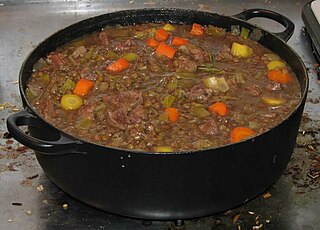
Tomato sauce can refer to a large number of different sauces made primarily from tomatoes, usually to be served as part of a dish, rather than as a condiment. Tomato sauces are common for meat and vegetables, but they are perhaps best known as bases for Mexican salsas or sauces for pasta dishes. Tomatoes have a rich flavor, high water content, soft flesh which breaks down easily, and the right composition to thicken into a sauce when they are cooked. All of these qualities make them ideal for simple and appealing sauces.

Chateaubriand steak is a meat dish cooked with a thick cut from the tenderloin filet. In contemporary times, chateaubriand cuts of beef refer to "a large steak cut from the thickest part of a fillet of beef".

Raita is the common name of a condiment, originating from the Indian subcontinent, made with dahi together with raw or cooked vegetables, more seldom fruit, or in the case of boondi raita, with fried droplets of batter made from besan.
Cacciatore means "hunter" in Italian. In cuisine, alla cacciatora refers to a meal prepared "hunter-style" with onions, herbs, usually tomatoes, often bell peppers, and sometimes wine.

Steak-frites, meaning "steak [and] fries" in French, is a very common and popular dish served in brasseries throughout Europe consisting of steak paired with French fries. It is considered by some to be the national dish of Belgium, which claims to be the place of its invention.

Lomo a lo pobre, bistec a lo pobre or bife a lo pobre its a dish from Chile and Perú. The common ingredientes for both preparations are the beef tenderloin topped with one or more fried eggs and the French fries. The ingredients that differtiate both dishes are the fried onions, as it is served in Chile, and the rice and fried plantains. Unlike steak and eggs, lomo a lo pobre is eaten as a lunch or dinner.

Breaded cutlet is a dish made from coating a cutlet of meat with breading or batter and either frying or baking it. Breaded cutlet is known as schnitzel in German-speaking countries, cotoletta or scaloppine in Italy, escalope in France, filete empanado in Spain, filete empanizado in Cuba, milanesa in Latin America, katsu in Japan and Korea, and kotlet in Poland.
Kabkabou or Kabkabu is a fish and tomato stew traditionally prepared in Tunisia. The dish is well appreciated as it is relatively healthy and easy to prepare. It consists of a sauce in which fish steak is cooked, and capers, olives and lemons are added. Many species of fish are used, such as grouper, angel shark, tuna or mackerel. The main ingredients used in the preparation are onion, olive oil, tomato paste, garlic, harissa, salt, pepper, cumin, caper, lemon, pitted black olives, pitted green olives and saffron.

Steak and eggs is a dish prepared with beefsteak and eggs as primary ingredients. It is most typically served as a breakfast or brunch food, although it can also be consumed at any mealtime, such as for dinner in the evening.

Wine sauce is a culinary sauce prepared with wine as a primary ingredient, heated and mixed with stock, butter, herbs, spices, onions, garlic and other ingredients. Several types of wines may be used, including red wine, white wine and port wine. Some versions are prepared using a reduction. Several types of wine sauces exist, and it is used in many dishes, including those prepared with seafood, poultry and beef. Wine sauces are associated with French cuisine.

Beurre Maître d'Hôtel, also referred to as Maître d'Hôtel butter, is a type of compound butter of French origin, prepared with butter, parsley, lemon juice, salt and pepper. It is a savory butter that is used on meats such as steak, fish, vegetables and other foods. It may be used in place of a sauce, and can significantly enhance a dish's flavor. Some variations with a sweet flavor exist. It is usually served cold as sliced disks on foods, and is sometimes served as a side condiment.

Riz gras is a meat- and rice-based dish in Burkinabé cuisine, the cuisine of Burkina Faso, Africa. It is also prepared in other African countries, such as Senegal and Guinea. It originated from the dish tiebou djen, a rice dish in Senegalese cuisine that is prepared with significant amounts of fish and meat.

Sautéed mushrooms is a flavorful dish prepared by sautéing edible mushrooms. It is served as a side dish, used as an ingredient in dishes such as coq au vin and beef bourguignon, in foods such as duxelles, as a topping for steaks and toast, and also as a garnish.

Hunter's chicken is a chicken dish that is a part of French cuisine. It shares the same name with other dishes from around the world, yet each national version is very different, with each sharing only the name, and the use of chicken as a primary ingredient. The primary ingredients in hunter's chicken are sautéed chicken and a reduced chasseur sauce prepared using tomatoes, mushrooms, onions, white wine, brandy and tarragon.
















